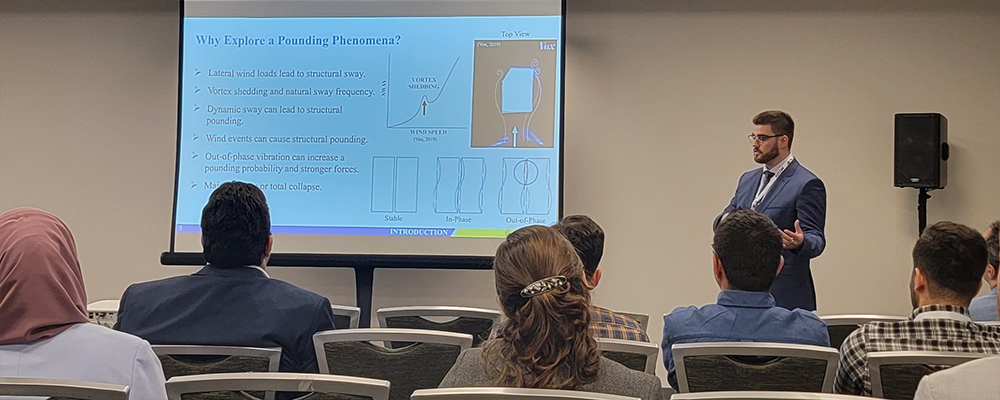Building Better Housing for Northern Indigenous Communities
The Saanich Indigenous Housing Carousel in British Columbia is an example of affordable modular housing that Tristen would like to bring to Northern Indigenous communities.
Tristen Brown is determined to create safe and affordable housing for Northern Indigenous communities.
Tristen, who grew up in a small town in the foothills of the Rockies, says, "As an Indigenous person, I could see the difference between the housing on my reserve and the housing in off-reserve cities."
His experience is backed up by facts. Between 2011 and 2016, Statistics Canada found that 43.9% of households on reserves lived in dwellings that were either crowded, needed major repairs, or cost 30% or more of their income.
Now, as a civil engineering PhD student, Tristen is in a position to do something about it.
"When my professor Dr. Ahmed Elshaer approached me to join his strategic research project on Indigenous housing, I was eager to take part. My sister has a career in Indigenous tourism and my mom is a tour guide who does plant walks, drumming, and singing in Jasper National Park. I want to follow their path and branch out from it," he says.
 Even though Tristen has always earned top marks in his classes, he's surprised at where his lifelong love of engineering has taken him. "I never expected that I would get a PhD, ever. It was little steps to get me to this point."
Even though Tristen has always earned top marks in his classes, he's surprised at where his lifelong love of engineering has taken him. "I never expected that I would get a PhD, ever. It was little steps to get me to this point."
Even before joining the college transfer program at Lakehead, Tristen excelled in the field of civil engineering—an interest that developed while working with a landscaping firm after high school.
"We were given landscape blueprints to follow, but many of the drawings were not accurate, and that really bugged me. It pushed me towards getting a civil engineering technologist diploma."
Since then, he's earned a Bachelor of Engineering in Civil Engineering and a Master of Science in Civil Engineering at Lakehead and had his bachelor's research examining the effects of extreme wind on solar panels published in an academic journal after presenting it at a research conference in South Korea. He's also conducted master's research examining structural collision on tall buildings subjected to extreme winds and received two graduate research scholarships in the process. In addition, Tristen participates in Lakehead's Engineering Student Panel and volunteers with the University's Office of Indigenous Initiatives.
"In the summer I recorded a welcome video for Indigenous high school students to make them feel comfortable about coming to study at Lakehead," Tristen says.
 Much of Tristen's previous research focused on wind analysis. His master's thesis looked at how to prevent strong winds from causing tall buildings to collide with each other.
Much of Tristen's previous research focused on wind analysis. His master's thesis looked at how to prevent strong winds from causing tall buildings to collide with each other.
He's now part of an innovative modular home design research project led by Dr. Elshaer. The goal is to improve the quality of housing in Northern Indigenous communities and to help end the chronic housing shortage these communities face.
"Not only do the Canadian building design codes need updating," Tristen says, "they aren't up to par when it comes to the severe weather in the more northerly parts of Canada, which is being worsened by climate change."
The construction methods and building materials used to build homes are compounding the problem.
"The majority of Northern homes are regular frame construction," Tristen says, "which means that you have to hire plumbing and electrical crews as well as a construction crew to build the framing and pour the concrete for the foundations."
This building method can become expensive and when the cost of transporting material is coupled with the short construction season in the North, it becomes even more challenging. The research being done by Tristen and started by Dr. Elshaer shows that modular housing is an optimal solution for overcoming such obstacles.
"Modular housing can be built in one location and then transported elsewhere, so it requires less construction time than conventional homes."
The solutions that Tristen will be helping develop will adhere to rigorous design code standards to keep the housing feasible and affordable. Performance tests will also be conducted to ensure that these modular units can withstand extreme Northern weather.
"We're planning on working with two industrial partners who will give us material to test, which will allow them to optimize their designs. We will also share the research with Northern communities so that they can apply these housing solutions.
"At the end of the day," Tristen says, "this research could provide a real-world solution that has a tangible impact. I really want to make the lives of Indigenous communities better, especially being part of that culture."
